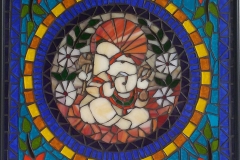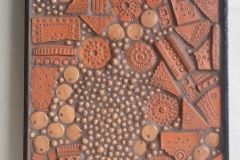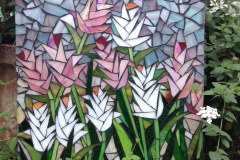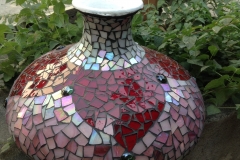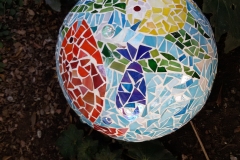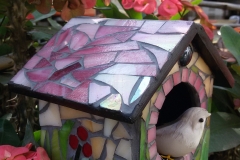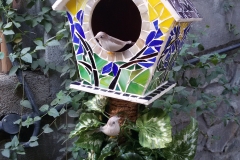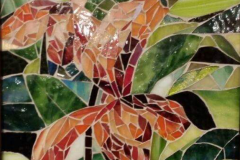*Please give us an introduction on yourself.
I am Rajashree Dadarkar, From Pune. I am an artist and I have been working in the field of Art for the past four decades.
I completed Diploma in commercial art- G.D Art – in 1978, from Abhinav Kala Vidyalay Pune.
For the final year exams, we went to J. J School of Arts, Mumbai. During that time we got a chance to visit the Jahangir Art gallery on frequent basis to see the various art exhibitions. That was the time I developed a keen interest in the field of Handicrafts.
After college, I started freelancing in commercial art, but I did not find that satisfying and interesting.
During that time, I got married to Sanjay, an artist from the Fine Arts background. In our Art journey together we both had a lot of influences on each other as we both loved Art and we started our journey together and we worked on many big projects together. My husband had keen interest in Ceramics and he took training in pottery and Ceramics from Gramoday Sangh, Chandrapur District, near Nagpur.
We both frequently visited the training institute; I too did a short training course in pottery. As we both were from the city like Pune, we had to face a lot of problems in staying in small village like Bhadrawati but working on the potter’s wheel, and complete procedure right from making to baking of clay fascinated us. The clay as a medium of art, huge furnaces and the pottery unit like Gramoday Sangh, the atmosphere, the production, all was like a wonder for me. That was the time I felt that I have found the medium of art that I was looking for.
The GURU of my Husband in this field was Late Mr. Krishnamurthy Mirmira. My Husband was his most favourite student so I became his student-cum-daughter-in-law. Staying at Bhadrawati and working with clay, the days were like a dream and we started dreaming about having our own pottery studio at Pune.
The dream came true in 1980 and we got a loan from Khadi and Village industry for a Studio Pottery unit in the rural development program. The loan was for rural development, we started our studio 7-8 kms away from the city area, where there was no water and electricity but just the place to work.
We started experimenting with clay. In 1982, we did our first individual exhibition in ceramics and that was a great success and in the same month I gave birth to a baby girl.
It was a struggle in life on different levels; I was trying to work in the studio and at the same time looking after my little one. I learnt a lot from my husband at that time. He was very good at understanding the science behind the pottery and ceramics and he was very experimental in Art forms.
Between 1982-1988, Sanjay did 4 exhibitions in glazed pottery at Jahangir Art gallery, Mumbai, and I did my first solo exhibition of Terracotta Lamps before Diwali in Pune. The exhibition was successful. People admired the work and that was very encouraging.
With that success and experience, we never looked back then. We divided our studio into 2 streams. My husband moved to Murals and Stained-glass and I focused on terracotta pottery. I had 17 individual exhibitions in terracotta lamps. I was also fortunate to be able to give training to the ladies from rural area. And this is how we established our studio and business in handicrafts. Meanwhile we had our second child, my son. I continued to work and did a lot of exhibitions and Art shows. But during late 1990s I stopped working in Terracotta pottery as I developed some medical problems due to spending long hours on the potter’s wheel.
That was the time my husband and I started working with stained glass and we started learning the new medium by reading lots of books and experimenting with the glass. We got a chance to complete a number of commissioned jobs in stained-glass and we realised we had found one more medium of Art that we could focus on. My Husband started taking big projects in stained glass like huge domes, window panels, etc. and at the same time continuing the work in ceramic murals, Fibreglass domes, Tiffany lamps. I was helping him to complete the projects but the main driver in all the decision-making was him. He was the artist who introduced the Original Stained Glass Work to the people of Pune.
I was always looking at him experimenting in various art forms and mediums and I used to rely on him for all his technical knowledge.
When I look back now, I feel I was indirectly learning from him, which helps me today when he is not with me. He suddenly passed away in 2011 at the age of 54 and I was left with the daunting task of managing the studio without him.
Again the struggle started in a different way. The studio was fully established with all the tools and equipment but suddenly everything stopped. The commissioned jobs had stopped. No one knew that I could work in Stained glass because I was known for my Terracotta Lamps. This is how the studio activity stopped suddenly. I also did not have the courage to go to the studio… that emptiness without my husband was unbearable.
But the last big stained glass panel project that my husband had undertaken was incomplete because of his unexpected death. So I brought together all my strength and courage to face the situation and completed that panel. The first piece of stained glass panel which I completed on my responsibility was big in size, 10 feet * 4 feet. I did the job well.
After finishing the project, I discovered that it is impossible for me to live without creating something. I could not see our studio all quiet, without any artistic creation. My children were doing well with their own field of choice, so I had to do something of mine to keep the studio going.
I didn’t like the idea to sell all the raw material we had in our studio and stop everything. I started working in the studio not for money but only to keep myself busy and to keep the studio going. I was not thinking much and just tried to keep myself busy.
I was looking all around the studio where I found a lot of material like ceramic tiles, boxes filled with glass shards, ply woods, PVC foam sheets, Acrylic sheets, mirrors, sheets of stained glass, dozens of copper foils and kilos of solder wire, Terracotta clay bags etc. And I decided to make full use of the material I already had. For the last 6 years I am doing the same.
*How did you stumble onto mosaics and how long ago was that?
I was completely unaware of the use of stained glass in mosaics. During our Europe trip in 2010, we saw mosaics made with tiles, millefiori, marble mosaic tiles and stones. But how to use glass shards was a challenge in front of me. We had big investments in the imported glass we had purchased. And when we completed big projects we never threw away the tiny pieces of glass left behind. While doing the research on Internet I found some websites on glass mosaics and I started experimenting in stained glass mosaic in 2012. I found this medium of art very interesting. As I was working in stained glass for many years before, cutting glass shapes for mosaics was easy for me. I made a nursery themed glass mosaic for my grandson as a gift for his first birthday which looked very adorable and got appreciated by a lot of people. So I started making more and more through my research and experiments in mosaic, and started learning about different surfaces and glues. A lot of raw material was already available in the studio. Now it has been almost 5 years I have been working with mosaics. I am using stained glass but I am also experimenting with more textures in my mosaic.
*What is your preferred mosaic media and how do you source it? Do tell us about the challenges you face in its sourcing.
When we started working in stained glass 20 years ago, there were no online sources of getting the raw material. Slowly we found suppliers in Mumbai.
We never got any stained glass material in the local market at Pune.
I preferred stained glass only because I have a lot of material in stock. I personally would love to use other mosaic material along with stained glass. I want to experiment with terracotta and glass tesserae together.
We have also bought some tools from abroad, mainly USA and Europe.
*What all have you made in mosaics? What all do you plan to make in the future?
I have tried mosaic picture frames, mosaic over terracotta pots for garden display, mosaic over thermocol balls for garden display, mosaic tiles, birdhouses, etc.
I want to plan and work for an exhibition of mosaic art, in which I want to introduce the complete procedure of mosaic-making to people.
*What are you currently working on?
I am working on birdhouses. I make them with PVC foam sheets right from cutting them, making shapes and then mosaic them with glass pieces. With the use of coloured glass they look pretty.
PVC foam sheet is synthetic material so it’s totally waterproof and can hang in gardens.
*Where do you find inspiration for your compositions? What kind of themes interest you?
I get inspiration from nature. The colours and shapes inspire me. I would love to use different textures in mosaic.
I want to experiment with terracotta mosaic. I have made 2-3 pieces, but still need to do a lot. For the last 6 years I have worked in all three mediums i.e. Terracotta, Stained glass and Mosaic.
*What is the typical size of your mosaic pieces? How long does it take you on average to complete a mosaic?
The size can range from small 3-4 inches pieces to upto 2 feet long. It can take from a few hours to few days to complete the mosaic depending upon the design and size. I can sit with patience for a long period.
*What challenges have you encountered in mosaic-making?
When I started working in mosaic, I found it very challenging because it is a new technique not much used in India. So it was very difficult to get practical experience and I had to learn a lot by experimenting and learning from mistakes. I strongly feel that the Art colleges in India should introduce such different form of Arts in their curriculum.
Coloured glass as a medium doesn’t have smooth surface so I faced a problem like trapping of air bubbles under the glass, problems with bonding of glue for glass on glass mosaic. Yet to try different glues on different surfaces and learn more.
During my visit to United Kingdom, I also got a chance to visit a glass Mosaic Artist and I learned a lot during that visit.
*Mosaic as an art charms even non-artists as it brings all the focus on the process or on working out the flow of tesserae. Many folks seem to find the art instantly therapeutic. Do you or your students feel that way?
Yes definitely. Even I feel when the things in life were shattered and when there was not much hope to bring it together, I tried mosaic, which was a totally new thing for me. I started gluing piece by piece, kept myself busy and focussed on my work and survived from the big loss in my life.
Today, life is not simple and easy. Lots of problems and challenges everybody has to face in each and every field. You have to face it and accept the challenges. Art and craft is a stress and depression buster. It brings out creativity in you and it keeps your mind occupied in making something beautiful and new every time. There is absolutely no need to be an artist to make mosaics. The only thing that is needed is a WISH to create something with your hands and I am glad I am working in glass and clay that gave me this opportunity. I love the freedom of mosaics.
*What is your wishlist for mosaics in India?
I wish, we all mosaic artist in India should meet and exchange the experience. People like you (Jyoti) are doing a great job and helping us find much more in mosaic art, its equipment, and tools.
Thinking of the city I live in, that is Pune, there are very few people who know stained glass work and mosaic as a form of Art. The main aim of taking workshops in Terracotta, Stained glass and Mosaics is to make people aware of these mediums of art. I would love to conduct a workshop for art lovers in Pune, with well-known mosaic artists from India.
*What is your view of the Facebook group Mosaic India and its website? What principles should it promote in the future?
It’s been one year that I have joined this group. You are doing a great job. We can share our thoughts and ideas on this page. Discuss the problems with each other. While teaching mosaics, I tell the students to refer to useful links from your website. It helps students to know more about mosaics.
*What is your advice to a new mosaic learner who is based in India?
I haven’t worked a lot in mosaic to give advice to new learners. I can only say there is no other way to achieve something without hard work.
*Are there any learning resources or mosaic artists you would like to point new learners to?
Internet can be the guide for everything now a days and same applies to Mosaics as well.
I love the work of Solly-John-d-sollinger, Candace Clough and Michelle Combeau so learners should see the work by these artists.
*Is there your gallery link or website that you would like to share with others?
https://www.facebook.com/profile.php?id=100007066097842
https://www.facebook.com/Dadarkarartstudio/
*Any mosaic or art based philosophy that you’d like to be known by?
I feel when we create a mosaic with glass shards or, better to say, waste glass left behind after cutting perfect shapes, that waste too can be transformed into beautiful art pieces. Only thing that you need is vision. Nothing is waste….you can create something from nothing.
Do share with us some of your creations.
………………………………………………………………………………
Mrs. Rajashree Dadarkar runs a busy art studio in Pune where she creates varied handicraft and teaches pottery, traditional stained glass work and mosaic-making to children and adults.
This interview was carried out by email and the questions were compiled by Jyoti Bhargava.




















 hardware store on a visit but not on my next one. It’s worth checking with local stores on its availability. Other local brands do not have good quality blades even if they look like these. Approx. Price: Rs250.00
hardware store on a visit but not on my next one. It’s worth checking with local stores on its availability. Other local brands do not have good quality blades even if they look like these. Approx. Price: Rs250.00 good choice for shaping ceramic tiles. Their jaw has straight blades that aid breaking of ceramic tiles from the tile’s edge. Approx. Price: Rs1400.00
good choice for shaping ceramic tiles. Their jaw has straight blades that aid breaking of ceramic tiles from the tile’s edge. Approx. Price: Rs1400.00







 s – the different materials that were used in those days and photographs of these mosaics, on floors and on walls. It goes on to the works of the famous Antoni Gaudi that fill the city of Barcelona, Spain. This ancient art of mosaic is very much alive today and this book portrays not only the historical mosaics, but also modern day, contemporary artists.
s – the different materials that were used in those days and photographs of these mosaics, on floors and on walls. It goes on to the works of the famous Antoni Gaudi that fill the city of Barcelona, Spain. This ancient art of mosaic is very much alive today and this book portrays not only the historical mosaics, but also modern day, contemporary artists. 